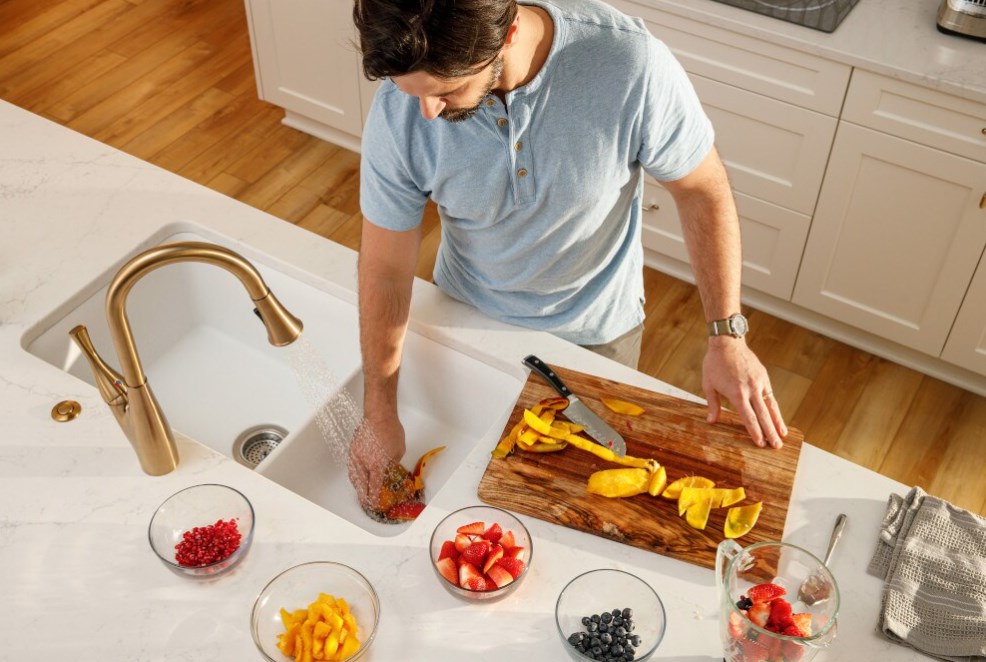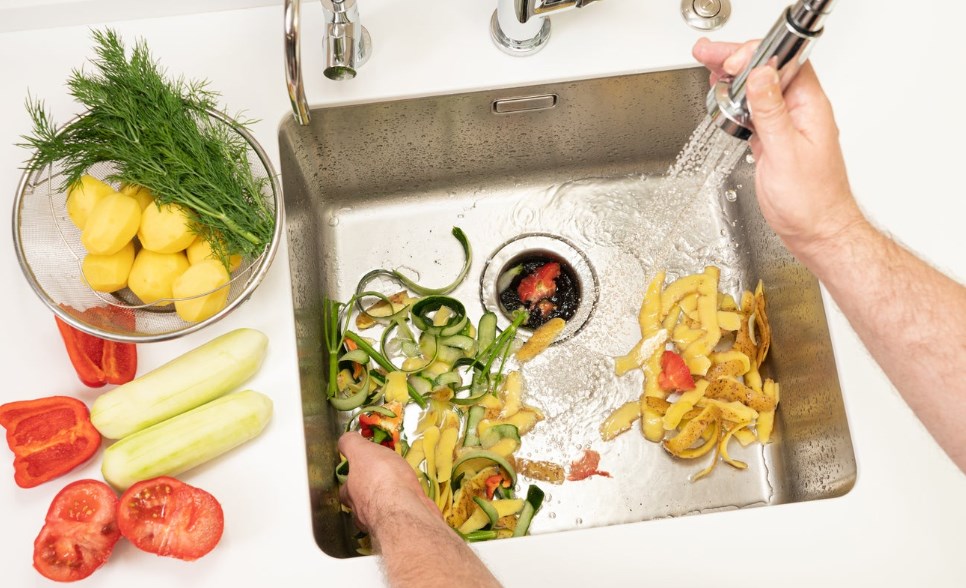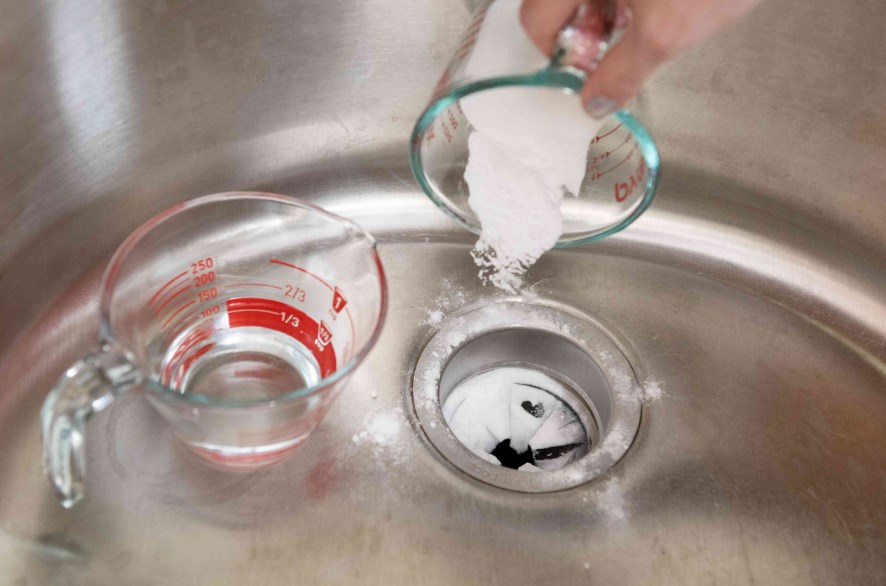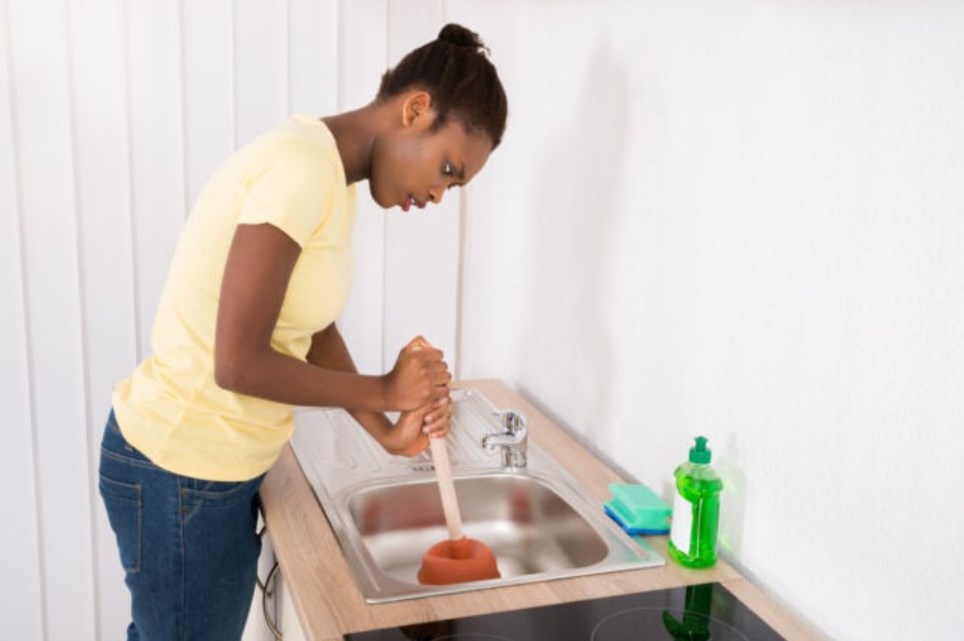The garbage disposal can cause frequent clogs, which can be a real problem for your kitchen sink. The cause of a clogged garbage disposal can be hard to find because garbage disposal clog can be from a single item, multiple items over time, multiple items at once, or a non-food item. A clogged garbage disposal can also form in the vanes, inside the structure, or in the sink drain pipe.
In this article, you will learn how to unclog a garbage disposal, how to clean it, and how to prevent re-clogging.

Reasons why clogged garbage disposal
If the bin is unable to grind food and flush food waste through the sewer, it may be clogged for some reason. Clogging occurs due to faulty plastic parts and components, a faulty motor, stuck impeller garbage disposal blades, debris in the pipes, and too many food particles stuck in the garbage disposals.
Signs of blockage in the garbage disposals are easy to spot:
- The unit drain drains very slowly, or maybe not at all, leaving standing water
- You may notice bad odors coming from the garbage disposal unit
- The garbage disposal won’t turn on
Garbage disposals become clogged for the following reasons:
- Insufficient use of water during disposal runs
- Use of hot water while grinding food in the garbage disposal
- Filling the disposal with too much waste
- Send the wrong items down the drain and into the garbage disposal instead of throwing them away with other household waste
To avoid blockages, you should perform the following routines regularly:
- Read the disposal instructions.
- Be selective about what goes down the garbage disposal.
- Rely on a sink strainer or drain strainer.
- Shred food waste before sending it to the garbage disposal.
- Feed the garbage disposal at a slow pace.
- Use cold water to rinse the bin after use.
- Use the trash garbage disposal more often.
The biggest reason for clogged garbage disposal is food, but there are other reasons as well. Let’s take a look in detail.
Wrong product types
One common misconception about garbage cans is that they can handle any food you put inside, including all parts of the food. It is not true.
- Difficult to grind: Bones, pits, corncobs, seeds, and ice cubes are too difficult to dispose of.
- Fibrous items such as pasta, celery, asparagus, corn hulls/silk, lettuce, and banana peels will prevent the disposal from working properly.
- Grease and oil harden and clogged drain. Coffee grounds and eggshells turn into tiny and sticky granules, making it easy to get into small areas and cause blockage problems. Starchy vegetables such as beans and potato peels harden into a thick paste similar to fat and butter.
Too Much Too Fast
Another misconception is that a garbage disposal can process tons of food at once. This is also not true.
One way to tell if your garbage disposal is full is to make sure food isn’t moving around inside when you peek inside the garbage disposal with a flashlight. The second way to tell if you’ve overflowed the garbage disposal is to see the standing water and food mixture run down the kitchen sink.
When you put too much into the recycling at once, the recycling will grind a smaller portion at a time. This means that larger pieces pass through it, contributing to clogging and breaking the electrical circuit near the reset switch. You can try to apply a Grease Trap Treatment in emergency cases.
Non-food items
The only thing that should go down the garbage disposal is food. When non-food items come into contact with the bin, they may damage it.
- The silverware makes a grinding sound on contact, causing the device to jam. Paper, cloth, foil, plastic, washcloth, sponge, and flower plant trimmings are silent but contribute to clogging and sticking.
- Trimmings of flower plants, paper, and foil cut well, but contribute to clogging. If they get stuck in the pipeline, they will prevent other items from entering the sewer.
- Cloth, plastic, sponges, and washcloths also do not cut the impeller blades well. An attempt by the garbage truck to shred these items will result in jamming.
Do not flush the remaining waste
After use, the grinder switches to “off” mode and only turns on again when it’s time to grind more food. This is the wrong way to use recycling.
Therefore, the correct way to use the chopper is to leave it on after the food has been chopped. At this time, turn on the water and let it run for one minute to remove debris stuck inside. Then turn off the device.
Hot Water
The temperature of the rinse water you use to clear the disposal matters – hot water is not the right type of water. Hot water spreads fats, oils, and grease around the bin and into the drain pipes. When oils and fats dry out, they harden, making room for more food to sit and clog.

Tips on how to unclog a garbage disposal yourself
Unclogging garbage disposals are not always a difficult job.
An effective home remedy is baking soda and vinegar. Use a natural cleaner made from a quarter-cup of baking soda followed by a half-cup of vinegar. This combination of effervescent foam cuts through food blockages and cleans the device. This solution is especially good for drain cleaning grease and oil, as well as deodorizing stinky garbage disposals.
- Pour soda down the trash disposal.
- Pour the vinegar down the garbage disposal.
- Wait 20 minutes for the hissing to break up the blockage.
- Rinse the mixture and food waste through the drain pipes with hot water.
If the home remedy did not help clear the garbage disposal, the first thing you should do is look inside the disposer to see what is causing the blockage. Use a flashlight and pliers or tongs to see the clog. Simply insert pliers or tongs inside the device and remove the loose item. Repeat this process until you have removed all items or debris from the disposal.
The blades of garbage disposal are very sharp, so it’s important to follow these tips to safely clean your garbage disposal at home. Never put your hands into the sewer, especially when the garbage disposal unit is powered. Instead, use tools.
What tools are needed to clean the garbage disposal:
- A standard kitchen sink plunger
- Pliers forceps hex key
- Bucket
- Torch
- Beaker
- White vinegar
- Baking soda
Follow the steps below to clear the garbage disposal unit from blockages:
- Disconnect power from the device by all means possible.
- If there is water in your kitchen sink, you will need to use a plunger to push it out through the sink drain.
- Shine a flashlight through the drain valves to find a blockage in the garbage disposal canister.
- If you can’t see anything down the garbage disposal, there may not be a blockage at all. If the unit trips, the switch on the garbage disposal will stop the unit from operating – leading some to speculate that blockages are to blame.
- All you have to do is reset the switch – find the reset button on the underside of the garbage disposal and press the reset button once you find it to reset the system. Wait about 15 minutes for the disposer to cool down if it is overheated.
- If you notice that something has jammed the blades, flywheel, or engine, try the following:If you see something stuck inside a garbage disposal, don’t put your hand down the drain to grab it! Instead, insert forceps or pliers to get it out.
- Use these tools to loosen the item and remove it from the drain. If there is debris around the blades or in the container, use the tools to unroll the material and pull out the food particles, then throw them in the trash.
- If the motor or bin blades are stuck, or an object is too hard to remove with pliers or tongs, with the garbage disposal turned off, you can manually rotate the components to free them. Locate the hole in the center of the bin under the bin and insert a hex or hex wrench.
- Turn the key fully in both directions to free the moving parts. If you can then move the blades freely, remove the key from the insertion point.
- Plug the bin back into the outlet and turn on the switch to restore power.
- Run the water and turn on the switch of the garbage disposal.
- Let the water and garbage disposal system run for a minute and see if it drains the water.

Garbage disposal maintenance
Prevent trash bins from becoming clogged garbage disposal by taking care of them and using the trash properly. These tips will help you unclog garbage disposal :
- Use garbage disposal regularly. Run cold water through the device and turn it on briefly every few days, even if you don’t have waste to dispose of. Regular use prevents rust, which can cause parts to jam.
- Use only cold water when chopping food with the garbage disposal. The warm water heats fats, oils, and fats, causing them to turn into a liquid. As they pass through the garbage disposal unit and enter the drain pipe, they cool and stick to the pipe walls.
- Be careful what you throw in the trash garbage disposal. Dispose of coffee grounds, banana peels, fibrous vegetables, fats, oils, fat, pasta, rice, eggshells, seafood shells, bones, nuts, fruit bones, and chicken skins in the trash.
- Don’t stuff the garbage disposal with food. If you have a lot of waste to recycle, do it in small batches. You will avoid overloading the garbage disposal, which will prevent overheating and clogging.
- Make sure you use enough cold water when shredding trash. Turn on cold water before turning on the garbage disposal unit, leave it running until your garbage disposal completes its task, and let it run for about a few seconds after grinding is complete to flush any leftovers down the drain.
- Empty the bin regularly—about once every two weeks.
- Do not use commercial cleaners to unclog a garbage disposal. These cleaners can ruin your plumbing.
- Pass small portions of citrus peels through the garbage disposal for a pleasant smell.

FAQs
How do you manually unclog a garbage disposal?
The easiest way is to use a natural cleaner made from a quarter-cup of soda followed by a half-cup of vinegar. This combination of effervescent foam cuts through food blockages and cleans the garbage disposal.
Will baking soda and vinegar unclog a garbage disposal?
Yes, this combination will help to cope with the clogged garbage disposal, but only when it is not heavily contaminated with waste. But if there is non-food waste in the garbage disposal, soda will not cope with the blockage.
How do you unclog a garbage disposal with standing water?
If there is water in your sink, you will need to use a plunger to push it out through the drain.
How do you unclog a garbage disposal that won’t drain?
To clear blockages in the pipes, you need to invite a plumber to fix the drain.
Can you put Drano down a garbage disposal?
Don’t recommend using harsh cleaning products like Drano at all, especially not down a sink that has a garbage disposal in it. Drain cleaning products that are caustic or acidic wear down, fittings, and your garbage disposal itself.
Conclusion
Take care of your garbage disposal by maintaining it according to the manufacturer’s instructions. To prevent garbage bins from becoming clogged, you need to ensure that they are disposed of properly.
Read also: How to dispose of dry ice safely

